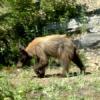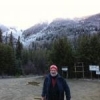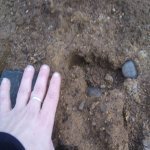Leaderboard
Popular Content
Showing content with the highest reputation on 01/05/2022 in all areas
-
How about weird science? I do weird science and try to do weird science every day. First, throw out reflectance. Go down your animal inventory list, including yourself because humans have eyeshine. Look at the shape of the eyes and shape of the pupils. Round eyes, elongated eyes. Round pupils, vertical slits, horizontal slits. How fast do animal pupils react? Humans have eyeshine and our pupils react very fast. Have you been the victim of 'red eye' in flash photography? The 'pre-flash' was developed to minimize red eye. The pre-flash emits enough light before image capture to make our pupils react and close down. Forget reflectance. Using human vision to make wild ass guesses about Sasquatch vision is speculative. Human color perception is subjective. I am game. Primate evolution is assumed. Night vision, scotopic, is without color and done with rods. Day vision, photopic, with color, is done with cones: red, green and blue. Rods have peak sensitivity of about 498nm, in the green-blue region. Red cones have a range of about 500nm--700nm, with peak sensitivity about 564nm--580nm. Green cones have a range of about 450nm--630nm, with peak sensitivity about 534nm---555nm. ( hint hint hint notice I am not listing the blue cone ). Photons hit the retina and electrical impulses are created. There is a delay between the impulses and they do not arrive at the vision processing areas simultaneously. The delay in signals is 10s of milliseconds but it all comes together to make images. Cones and rods operate in an 'on-off' scenario to send signals. There are several different channels used to send signals. Red-green use one channel. Blue-yellow use a separate channel. The rod channel, black and white, is the luminance channel. Our visual signals are pulsed. This brings up 'critical fusion flicker frequency'. Anyone have trouble with flickering flourescent lights? I have not seen projected light. I am aware of red and green light. Is the light pulsed? If pulsed, and the rate is higher than the critical fusion flicker frequency then humans would see a continuous light. I am thinking that the rod cones aren't firing when the projected light occurs. If there is over lap, the luminance channel is separate from the red-green channel. Alternating visual signals and light emitting signals. The retina can generate its own flourescence. The deepest layer of cells of the retina are called 'retinal pigment epithelium', ( RPE ) and contain flourescent compounds. Weird science never rests. CAT I reviewed emails. So far, time of illumination is less than a minute.2 points
-
Lots of great advice above. The beautiful thing about this forum is the wide variety of approaches and methodologies. You say that you have grown up in the outdoors, so I will skip any of the outdoors basics. 1) Always be recording. It doesn’t really matter what your goal is… obtaining evidence to advance the public’s acceptance of the existence of these creatures or simply seeking experiences of your own. The first time you hear or see something truly out of the ordinary and you don’t have any sort of film or audio running…you are going to always regret it. Don’t join the ranks of those of us who always bemoan the ‘one that got away’. Get an inexpensive digital audio recorder and a basic action cam off of Amazon. Start the digital recorder the moment you exit your vehicle. Experiment with the placement of the recorder on your pack…find the best spot that picks up the least amount of your own noise. Mount your action cam on your chest or pack…preferably with some sort of auxiliary power source to keep it running. You won’t have time to dig out your camera and get it filming if you encounter activity…you need to have it already going. You don’t need top of the line equipment to start out. You can always add or upgrade equipment later. If I can offer any suggestions to you on these items, please don’t hesitate to ask. Shoot me a message. 2) Try to identify a possible area to research that is within a couple of hours from your home. The further away your potential research area is…the less time you will spend there. Learn what wildlife inhabits that area…and more importantly learn how that wildlife effects their environment. We average a couple of bear prints a month that are sent to us by excited people thinking that they are hot on the trail of Bigfoot. You are probably familiar enough with the outdoors to avoid that pitfall, but get a baseline reading for what is normal in your area. A quick side note about your area…if you happen to run across anyone else while out there, NEVER tell them they you are looking for Sasquatch. You will open yourself up for possible hoaxing and will never really be able to trust the authenticity of anything you find or hear. If anyone asks why you are recording…you are starting a YouTube channel about your daily hikes. 3) If you don’t already, learn the basics of tracking…both animals and humans. Learn how to use the angle of the sun to your advantage in order to find possible prints easier. Learn how to search for sign…of course keep in mind that a tracking stick designed for finding human tracks will probably be to short for what you are looking for…. Don’t get so focused on finding that stereotypical perfect Bigfoot print that you never see other possible signs around you. You probably have a good grasp on outdoors equipment, however I will recommend two things… Personal locator beacons are getting more inexpensive all of the time. Get an Inreach Mini. Also, get a small tape measure to use to measuring the size of prints…especially in photographs. It gives a much more accurate representation of the size of the track than just laying a dollar bill or a lighter next to a print.2 points
-
All great input above. Good luck out there DrPSH. Part of what I assume outdoor experience means is knowing what sounds and sights are natural and when, much easier to sort the anomalies when one does. It can take time to learn most of the range of animal or even weather activity in a certain area but nowadays, that time can be decreased a bit by listening to the varied sounds of the local fauna on something like u tube or ebird. I like to identify, or attempt to, the flora I pass. Have done this for decades and typically without the added bulk of field guides along. What I've found is the process really teaches observation skills. How many times I've returned home to read a description and realize the details I'd missed, hampering positive ID. It taught me to see, to pay real attention. Good skills to develop out there. I'll just echo-- go where the people aren't and preferably bushwhack to get there--with a map/compass, a locator beacon of sorts and a good orientation of your standing in relation to the topography's obvious landmarks. They'll find you, whether we know it or not.1 point
-
Now that the floods are drained and some of the logging roads reopened to the public, I got out in the woods for a few hours today. Not a Squatchin' trip, just a run out to the Stave Lake mudflats to meet some 4x4 friends for a bonfire and BS session. It looked like every 'wheeler in the area had the same idea, but it was great to get out there anyway. Of course, when i went out yesterday to sweep the snow off the Hummer and check things out, the battery was completely flat, and wouldn't even jump from my little power booster, so I had to go get a new battery. The old one was a cheap no name that was in the truck when I bought the H3 15 months ago, and looked like it had been in there a long time. The only other problem was about a foot of door weather stripping was frozen to the driver's door sill, and pulled loose when I opened the door. Now I have to find the right glue for it, and a warm dry place to do the work.1 point
-
I have the one by Uberleben. It does work, but I'd hate to have to depend on it as my last resort, though. Plus, it just looks neat, as does yours!1 point
-
The problem that many Americans forget, when they are talking about government coverup, is that we would not be talking about 1 Federal government. At a minimum there would be 3 Federal governments involved, more if sasquatch reach into Central and South America or Asia. You are also talking about a coverup that has lasted decades, without major leaks. The Mexican cartels control the border like nobody else, imagine the money they would make off of a body or captured specimen, but where are they. If there was a decades long coverup going on across all of North America. you don't think that China or Russia wouldn't have at least got a whiff of it by now, and they would like nothing better than exposing a secret like this, even if for no other reason than to embarrass us. A coverup of this size would involve hundreds if not thousands of people over the last 50 years, and they have somehow guarded this secret, better than nuclear weapons.1 point
-
I don't think they evolved here ... not completely. It pays to remember that a) there have been 4 periods, not just 1, in the last 2.3 million years when there were land bridges between Asia and North America, (My guess o' the moment is that no matter what sasquatch proves to be, it crossed over during one of the earlier glacial maxima / sea level minima and has had sufficient time to evolve from whatever form they arrive in to the form they have now. ) and b) populations pushed by extreme conditions evolve more quickly because mutations with even small positive values become highly selected for, and c) small populations do not have the opportunity for mutations to be "buffered out". Everything adds up in an evolutionary sense. Given just a little more time, extreme conditions to adapt to, and a very small population, I think it is real possible for bigfoot to have evolved from a shared human ancestor in a few hundreds of thousands of years. MIB1 point
This leaderboard is set to New York/GMT-05:00








